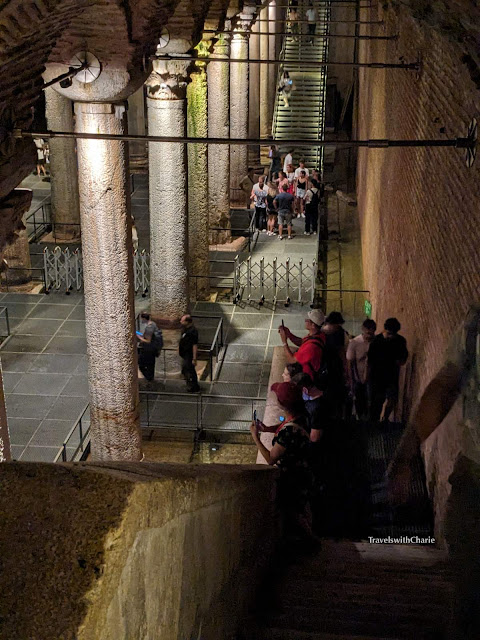Basilica Cistern (Yerebatan Sarayi)
The Basilica Cistern or the Sunken Palace, has been around since the 6th century when it was constructed as a reservoir for the palace of Constantinople and the surrounding neighborhood. It takes its name from the Stoa Basilica which once stood on the very same site.
There are 336 marble columns standing 30 ft. high supporting the ceiling. Many of these columns were recycled from the ruins of other buildings.
The vaulted ceiling and rounded arches remind one of the great cathedrals of Europe but the Cistern predates these cathedrals. It has been restored multiple times through the years and earthquake-proofed in 2017. The Cistern was reopened to the public in July 2022.
This is the bottom of the cistern with just enough water to reflect the columns and artworks scattered throughout. Visitors walk on raised walkways.
Here’s a Corinthian column decorated with acanthus leaves.
Peacock Eye or Column of Tears
This column may be a tribute to the slaves who died while constructing the Cistern.
These columns have a bell shaped base.
Two columns have the face of the Medusa as its base. These columns were only discovered in the 1980s when restoration of the Cistern was in progress. It has since been the prime attraction for visitors to the site.
Inverting the face of the Medusa is supposed to negate its power.
Seclusion, Muzaffer Tuncer
| There are several works of art strategically placed throughout the Cistern. It’s part of the exhibition, Deeper Beneath. The artworks lend a mystical air to this hypogean basin from centuries past. |
Sages, Ozan Ünal
Lily Lavi, Ozan Ünal
Glass Leaves, Ali Abayoğlu
Remember Tomorrow, Berman Bugdan
Shell, Ozan Ünal (in the background)
Jellyfish, Ali Abayoğlu
The Basilica Cistern ranks at the top of my favorite sites in Istanbul. View my video of the Cistern here: https://youtu.be/g9y7_PK2Kj0?feature=shared
Know before you go:
There is usually a long line of people outside the Cistern. To avoid this, it’s best to buy a ticket ahead of your visit so you can skip the queue. If you bought the Istanbul Pass, check if you have free or discounted entry to the site. For detailed information about the entrance fee, hours of operation and more, follow this link: http://yerebatansarnici.com/
*****
Images by TravelswithCharie

















